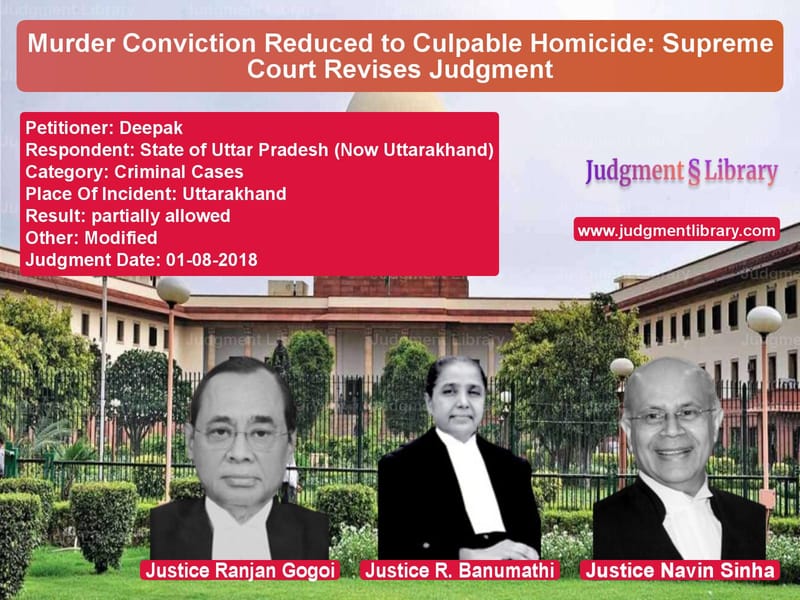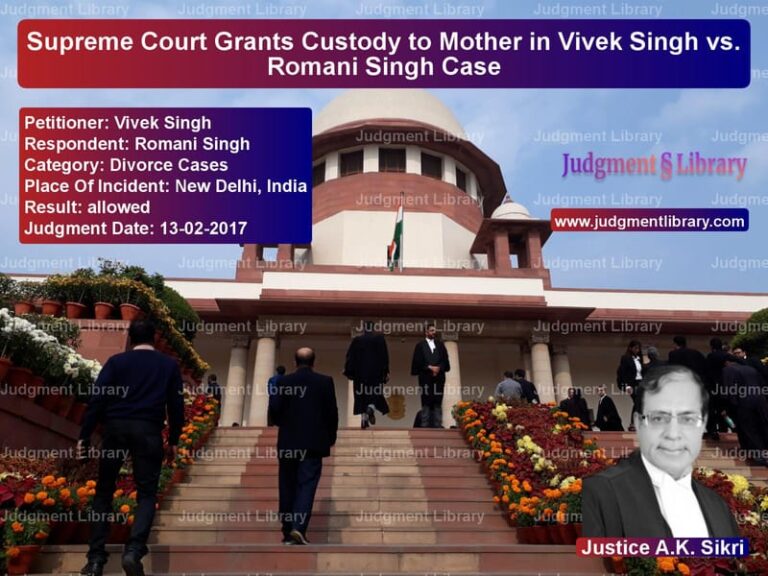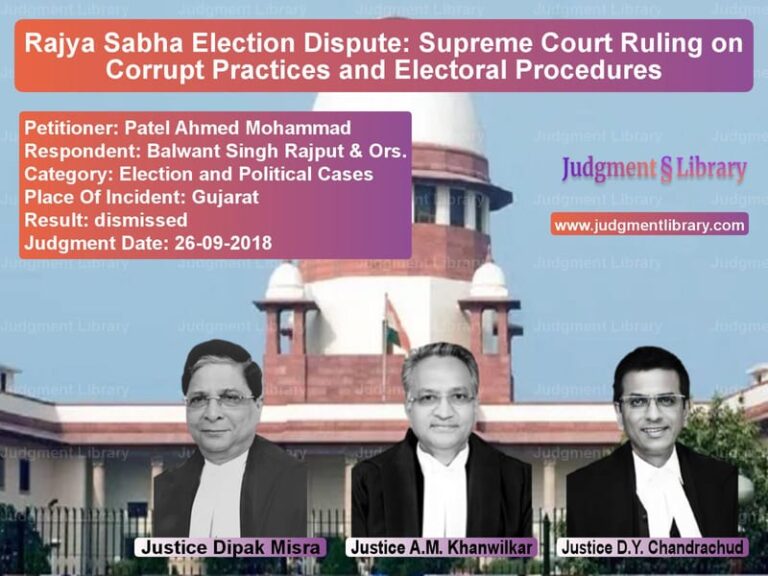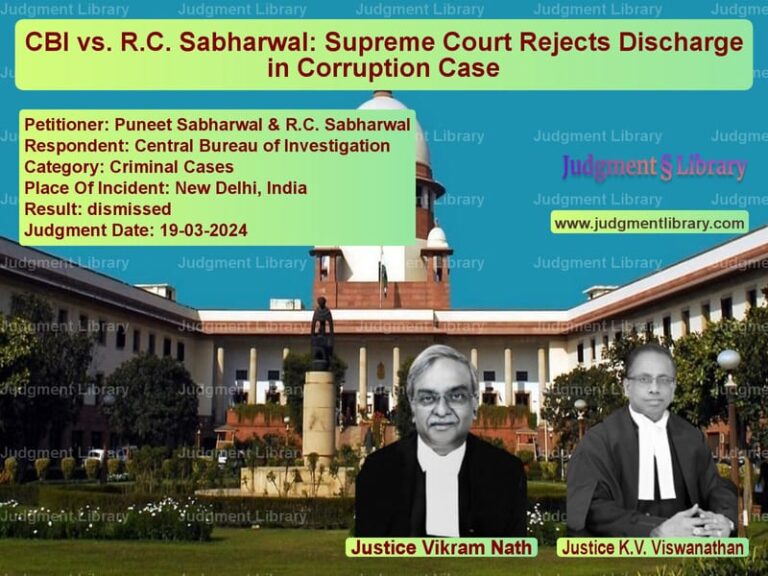Murder Conviction Reduced to Culpable Homicide: Supreme Court Revises Judgment
The case of Deepak vs. The State of Uttar Pradesh (Now Uttarakhand) revolves around the conviction of the appellant under Section 302 of the Indian Penal Code (IPC), which sentenced him to life imprisonment for murder. However, after reviewing the evidence, the Supreme Court revised the conviction to Section 304 Part II IPC, reducing the sentence to the period already served. The judgment highlights key considerations regarding intent, provocation, and proportionality of punishment in criminal cases.
Background of the Case
On 27th August 1993, at approximately 8:30 AM, the appellant and the deceased had a heated argument over the loud noise of a tape recorder being played by the deceased in his house. The altercation escalated, leading the appellant to rush to his house, retrieve a sword, and strike a single blow to the deceased’s rib cage. The injured was immediately taken for medical examination and was declared dead on the same day.
The medical examination was conducted by PW-8 Dr. S.K. Prabhakar, who found an incised wound measuring 2.5 cm x 2 cm. The post-mortem, conducted later by PW-5 Dr. P.K. Bhatnagar, confirmed that the cause of death was a punctured wound in the rib cage, which proved fatal.
Arguments by the Petitioner
The appellant challenged his conviction, arguing:
- The incident was a sudden quarrel, and there was no premeditation.
- The altercation lasted for only 1.5 to 2 minutes, indicating that the act was spontaneous.
- Only a single blow was inflicted, which does not establish an intention to kill.
- The High Court, while reversing the acquittal by the trial court, exaggerated minor contradictions in witness testimonies.
- His actions were driven by provocation due to the loud noise and frustration rather than a deliberate intent to murder.
Arguments by the Respondents
The prosecution, representing the State of Uttarakhand, argued:
- The attack was deliberate since the appellant had the opportunity to calm down but instead fetched a sword.
- Eye-witnesses PW-1 Babu Ram, PW-2 Ram Kumar, PW-3 Kalu Ram, and PW-4 Omwati (an injured witness) corroborated the prosecution’s version of the events.
- The trial court had wrongly granted the benefit of the doubt by overemphasizing minor discrepancies in witness testimonies.
- The High Court correctly held that the prosecution had established guilt beyond a reasonable doubt.
Supreme Court’s Analysis
Upon examining the case, the Supreme Court made the following observations:
- “The trial court has laid exaggerated emphasis, by erroneous appreciation of evidence, on minor omissions and contradictions in the evidence of PW-1, PW-2, and PW-3 so as to doubt the veracity of the entire prosecution case without any discussion of the injured eye-witness PW-4.”
- It acknowledged that the appellant and the deceased were neighbors, living in houses separated by 20-25 feet.
- “The genesis of the occurrence was the loud playing of a tape recorder in the house of the deceased, objected to by the Appellant.”
- The appellant did go to his house to fetch a sword but used it only once before fleeing, showing an absence of intent to ensure death.
- “Had there been any intention to do away with the life of the deceased, nothing prevented the Appellant from making a second assault to ensure his death, rather than to have run away.”
Supreme Court’s Judgment
Taking into account the nature of the attack and the circumstances surrounding it, the Supreme Court ruled:
- The conviction under Section 302 IPC was altered to Section 304 Part II IPC (culpable homicide not amounting to murder).
- The appellant’s sentence was reduced to the period of custody already undergone.
- The appellant was to be released immediately, provided he was not required in any other case.
Impact of the Judgment
The ruling establishes several key principles:
- The distinction between murder and culpable homicide depends on the intent and immediate circumstances of the crime.
- Single-blow cases should be analyzed in the context of provocation, absence of premeditation, and overall conduct of the accused.
- Courts must carefully re-examine lower court decisions to ensure that minor inconsistencies in witness statements do not unfairly benefit the accused or the prosecution.
Conclusion
The case of Deepak vs. The State of Uttar Pradesh (Now Uttarakhand) underscores the importance of distinguishing between spontaneous acts of violence and premeditated murder. The Supreme Court’s decision to downgrade the conviction ensures that the principle of proportionality is maintained in sentencing, reflecting the actual circumstances of the crime.
Petitioner Name: Deepak.Respondent Name: State of Uttar Pradesh (Now Uttarakhand).Judgment By: Justice Ranjan Gogoi, Justice R. Banumathi, Justice Navin Sinha.Place Of Incident: Uttarakhand.Judgment Date: 01-08-2018.
Don’t miss out on the full details! Download the complete judgment in PDF format below and gain valuable insights instantly!
Download Judgment: Deepak vs State of Uttar Prade Supreme Court of India Judgment Dated 01-08-2018.pdf
Direct Downlaod Judgment: Direct downlaod this Judgment
See all petitions in Murder Cases
See all petitions in Attempt to Murder Cases
See all petitions in Judgment by Ranjan Gogoi
See all petitions in Judgment by R. Banumathi
See all petitions in Judgment by Navin Sinha
See all petitions in partially allowed
See all petitions in Modified
See all petitions in supreme court of India judgments August 2018
See all petitions in 2018 judgments
See all posts in Criminal Cases Category
See all allowed petitions in Criminal Cases Category
See all Dismissed petitions in Criminal Cases Category
See all partially allowed petitions in Criminal Cases Category







